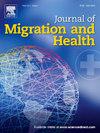新发房颤与不良临床结果的相关性:一项匹配的全国性队列研究
IF 2.9
Q1 PUBLIC, ENVIRONMENTAL & OCCUPATIONAL HEALTH
引用次数: 0
摘要
背景:房颤(AF)的发病率和患病率在全球范围内呈上升趋势,并且房颤与不良临床结果的高风险相关。越来越多的全球移民导致患者群体更加多样化,对移民中房颤相关结果的了解是有必要的。目的探讨丹麦移民人群房颤诊断后的临床结果。方法对1998年至2017年45岁的首次房颤患者与性别、年龄和原籍国匹配的非房颤人群(比例为1:5)进行随访。使用泊松回归并按原产国对临床结果进行分层:卒中、大出血、心力衰竭和全因死亡率。分析调整了性别、年龄、合并症、全科医生接触和社会经济变量。结果人口中有1940,010名丹麦人,47,952名来自10个最具代表性的国家之一。对于所有结果,诊断为房颤的个体调整后的发病率比(IRR)更高。对于卒中,来自巴基斯坦的个体观察到最低和最高的IRR (1.87 [95% CI: 1.14;3.07])和波黑(5.32 [95% CI: 3.37;7.93]),心力衰竭:伊拉克(5.06 [95% CI:3.07;8.34])和波黑(8.10 [95% CI: 6.07;10.80]),大出血:芬兰(2.04 [95% CI: 1.42;2.95])和南斯拉夫(3.53 [95% CI: 2.70;4.62]),死亡:德国(1.60 [95% CI: 1.51;1.69])和巴基斯坦(2.33 [95% CI: 1.83;2.98])。结论:在丹麦出生的和所有被检查的移民人群中,房颤与不良临床结果的风险显著升高相关。然而,房颤的影响似乎因原产国而异,这可能表明房颤护理和依从性的潜在差异。本文章由计算机程序翻译,如有差异,请以英文原文为准。
Association between new-onset atrial fibrillation and adverse clinical outcomes by country of origin: A matched nationwide cohort study
Background
Incidence and prevalence of atrial fibrillation (AF) is increasing worldwide, and the condition is associated with high risk of adverse clinical outcomes. Increasing global migration results in more diverse patient populations, and knowledge about AF-related outcomes in immigrants is warranted.
Aim
To examine clinical outcomes after AF diagnosis across migrant populations in Denmark.
Method
Patients with first-time AF and sex-, age- and country of origin matched non-AF population (ratio 1:5) were followed from age 45 from 1998 to 2017. Poisson regression was used and stratified by country of origin for the clinical outcomes: stroke, major bleeding, heart failure, and all-cause mortality. Analyses were adjusted for sex, age, comorbidity, contacts to general practitioners, and socioeconomic variables.
Results
The population contained 1,940,010 individuals of Danish origin and 47,952 with origin in one of the ten most represented countries. For all outcomes, the adjusted incidence rate ratio (IRR) was higher for individuals diagnosed with AF. For stroke, the lowest and highest IRR were observed for individuals from Pakistan (1.87 [95 %CI: 1.14; 3.07]) and Bosnia-Herzegovina (5.32 [95 %CI: 3.37;7.93]), for heart failure: Iraq (5.06 [95 %CI:3.07;8.34]) and Bosnia-Herzegovina (8.10 [95 %CI: 6.07;10.80]), for major bleeding: Finland (2.04 [95 %CI: 1.42;2.95]) and Yugoslavia (3.53 [95 %CI: 2.70;4.62]), and death: Germany (1.60 [95 %CI: 1.51;1.69]) and Pakistan (2.33 [95 %CI: 1.83;2.98]).
Conclusion
AF was associated with a substantially higher risk of adverse clinical outcomes among Danish-born, and all examined migrant populations. However, the impact of AF appeared to differ according to country of origin, which could indicate potential differences in AF care and compliance.
求助全文
通过发布文献求助,成功后即可免费获取论文全文。
去求助
来源期刊

Journal of Migration and Health
Social Sciences-Sociology and Political Science
CiteScore
5.70
自引率
8.70%
发文量
65
审稿时长
153 days
 求助内容:
求助内容: 应助结果提醒方式:
应助结果提醒方式:


